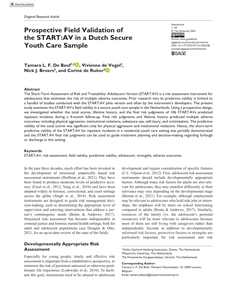Purpose Incidents of self-injury by forensic psychiatric patients often have a deleterious impact on all those involved. Moreover, self-injurious behaviour is an important predictor for violence towards others during treatment. The aim of this study is to analyse methods and severity of incidents of self-injury of patients admitted to forensic psychiatry, as well as the diagnoses of self-injuring patients. Design/methodology/approach All incidents of self-injury during treatment in a forensic psychiatric centre recorded between 2008 and 2019 were analysed and the severity was coded with the modified observed aggression scale+ (MOAS+). Findings In this period, 299 incidents of self-injury were recorded, displayed by 106 patients. Most of these incidents (87.6%) were classified as non-suicidal. Methods most often used were skin cutting with glass, broken plates, a razor or knife and swallowing dangerous objects or liquids. Ten patients died by suicide, almost all by suffocation with a rope or belt. The majority of the incidents was coded as severe or extreme with the MOAS+. Female patients were overrepresented and they caused on average three times more incidents than male patients. Practical implications More attention is warranted for self-injurious behaviour during forensic treatment considering the distressing consequences for both patients themselves, supervisors and witnesses. Adequate screening for risk of self-injurious behaviour could help to prevent this behaviour. Further research is needed in different forensic settings into predictors of self-injurious behaviour, more specifically, if there are distinct predictors for aggression to others versus to the self. Originality/value Incidents of self-injury occur with some regularity in forensic mental health care and are usually classified as severe. The impact of suicide (attempts) and incidents of self-injurious behaviour on all those involved can be enormous. More research is needed into the impact on all those involved, motivations, precipitants and functions of self-injurious behaviour and effective treatment of it.
DOCUMENT
Purpose Self-injury is common in forensic psychiatric settings. Recent research offers some insights into the functions and management of self-injurious behaviour but generally focusses on either the experiences of staff or patients. This study aims to explore the experiences of both staff and patients with non-suicidal self-injury in a Dutch forensic psychiatric hospital. Design/methodology/approach In total, 6 patients and 11 staff members were interviewed about the functions they ascribe to self-injurious behaviour, the emotional experience provoked by this behaviour and the management of self-injurious behaviour. The interviews were transcribed and analysed using a thematic analysis. Findings Four main themes resulted from the analysis: functions; emotional distancing; patient needs; and management. Overall, findings illustrate that staff reports limited knowledge of the different functions of self-injury. To circumvent potential automatic stereotypical judgement, staff should proactively engage in conversation about this topic with their patients. In managing self-injurious behaviour, clarity and uniformity among staff members should be promoted, and collaboration between the staff and patients is desirable. Staff recognised the potential benefit of a management guideline. Staff may find detached coping strategies to be effective but should be vigilant to not let this evolve into excessive detachment. Practical implications Increased knowledge and awareness of self-injury functions among staff can allow for better understanding and evaluation of self-injury incidents. Circumvention of automatic, stereotypical judgement of self-injurious behaviour is warranted, and more accessible explanations of the variety of functions of self-injury should be used. More proactive engagement in conversations about functions of self-injury by staff, can facilitate this. Detached coping can help staff to remain resilient in their job, but requires vigilance to prevent this from turning into excessive detachment. Clarity and uniformity among staff when managing self-injury incidents is considered beneficial by both patients and staff. A guideline may facilitate this. When imposing restrictions on patients, staff should strive to establish collaboration with the patient in determining the course of action and ensure the restriction is temporary. Originality/value The impact of self-injurious behaviour on all those involved can be enormous. More research is needed into experiences of both patients and staff members regarding the impact, motivations, precipitants and functions of self-injurious behaviour, and effective treatment of it.
LINK
The Short-Term Assessment of Risk and Treatability: Adolescent Version (START:AV) is a risk assessment instrument for adolescents that estimates the risk of multiple adverse outcomes. Prior research into its predictive validity is limited to a handful of studies conducted with the START:AV pilot version and often by the instrument’s developers. The present study examines the START:AV’s field validity in a secure youth care sample in the Netherlands. Using a prospective design, we investigated whether the total scores, lifetime history, and the final risk judgments of 106 START:AVs predicted inpatient incidents during a 4-month follow-up. Final risk judgments and lifetime history predicted multiple adverse outcomes, including physical aggression, institutional violations, substance use, self-injury, and victimization. The predictive validity of the total scores was significant only for physical aggression and institutional violations. Hence, the short-term predictive validity of the START:AV for inpatient incidents in a residential youth care setting was partially demonstrated and the START:AV final risk judgments can be used to guide treatment planning and decision-making regarding furlough or discharge in this setting.
DOCUMENT
